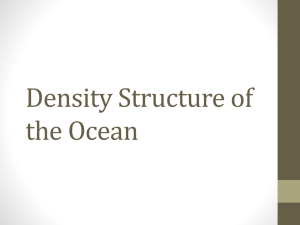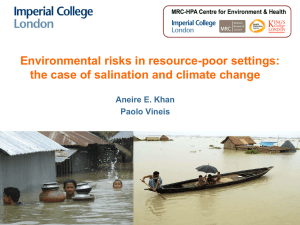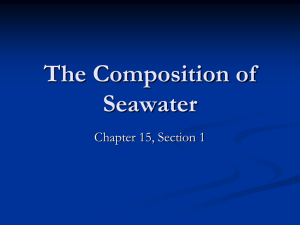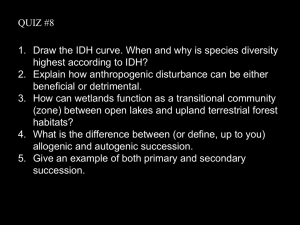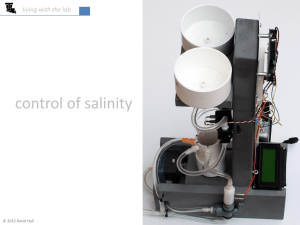Poster
advertisement
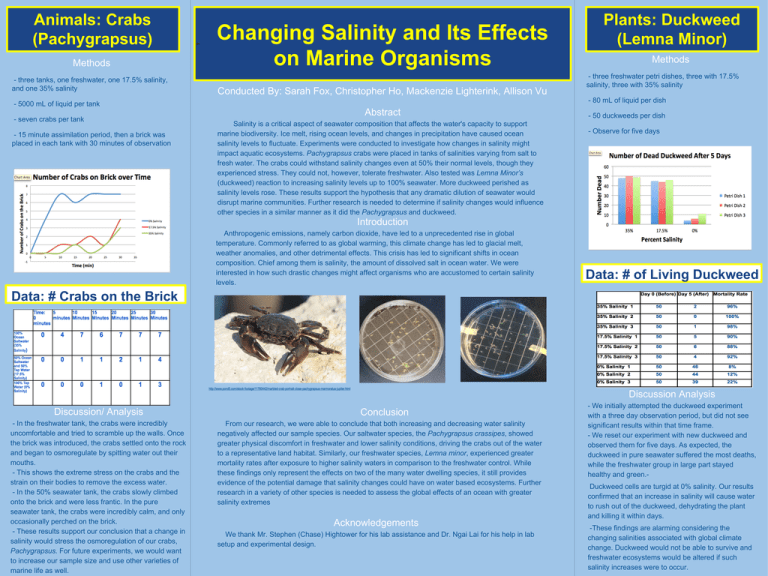
Animals: Crabs (Pachygrapsus) Methods - three tanks, one freshwater, one 17.5% salinity, and one 35% salinity ari Changing Salinity and Its Effects on Marine Organisms Conducted By: Sarah Fox, Christopher Ho, Mackenzie Lighterink, Allison Vu - 15 minute assimilation period, then a brick was placed in each tank with 30 minutes of observation Methods - three freshwater petri dishes, three with 17.5% salinity, three with 35% salinity - 80 mL of liquid per dish - 5000 mL of liquid per tank - seven crabs per tank Plants: Duckweed (Lemna Minor) Abstract Salinity is a critical aspect of seawater composition that affects the water's capacity to support marine biodiversity. Ice melt, rising ocean levels, and changes in precipitation have caused ocean salinity levels to fluctuate. Experiments were conducted to investigate how changes in salinity might impact aquatic ecosystems. Pachygrapsus crabs were placed in tanks of salinities varying from salt to fresh water. The crabs could withstand salinity changes even at 50% their normal levels, though they experienced stress. They could not, however, tolerate freshwater. Also tested was Lemna Minor’s (duckweed) reaction to increasing salinity levels up to 100% seawater. More duckweed perished as salinity levels rose. These results support the hypothesis that any dramatic dilution of seawater would disrupt marine communities. Further research is needed to determine if salinity changes would influence other species in a similar manner as it did the Pachygrapsus and duckweed. - 50 duckweeds per dish - Observe for five days Introduction Anthropogenic emissions, namely carbon dioxide, have led to a unprecedented rise in global temperature. Commonly referred to as global warming, this climate change has led to glacial melt, weather anomalies, and other detrimental effects. This crisis has led to significant shifts in ocean composition. Chief among them is salinity, the amount of dissolved salt in ocean water. We were interested in how such drastic changes might affect organisms who are accustomed to certain salinity levels. Data: # of Living Duckweed Data: # Crabs on the Brick Discussion Analysis Discussion/ Analysis - In the freshwater tank, the crabs were incredibly uncomfortable and tried to scramble up the walls. Once the brick was introduced, the crabs settled onto the rock and began to osmoregulate by spitting water out their mouths. - This shows the extreme stress on the crabs and the strain on their bodies to remove the excess water. - In the 50% seawater tank, the crabs slowly climbed onto the brick and were less frantic. In the pure seawater tank, the crabs were incredibly calm, and only occasionally perched on the brick. - These results support our conclusion that a change in salinity would stress the osmoregulation of our crabs, Pachygrapsus. For future experiments, we would want to increase our sample size and use other varieties of marine life as well. Conclusion From our research, we were able to conclude that both increasing and decreasing water salinity negatively affected our sample species. Our saltwater species, the Pachygrapsus crassipes, showed greater physical discomfort in freshwater and lower salinity conditions, driving the crabs out of the water to a representative land habitat. Similarly, our freshwater species, Lemna minor, experienced greater mortality rates after exposure to higher salinity waters in comparison to the freshwater control. While these findings only represent the effects on two of the many water dwelling species, it still provides evidence of the potential damage that salinity changes could have on water based ecosystems. Further research in a variety of other species is needed to assess the global effects of an ocean with greater salinity extremes Acknowledgements We thank Mr. Stephen (Chase) Hightower for his lab assistance and Dr. Ngai Lai for his help in lab setup and experimental design. - We initially attempted the duckweed experiment with a three day observation period, but did not see significant results within that time frame. - We reset our experiment with new duckweed and observed them for five days. As expected, the duckweed in pure seawater suffered the most deaths, while the freshwater group in large part stayed healthy and green.Duckweed cells are turgid at 0% salinity. Our results confirmed that an increase in salinity will cause water to rush out of the duckweed, dehydrating the plant and killing it within days. -These findings are alarming considering the changing salinities associated with global climate change. Duckweed would not be able to survive and freshwater ecosystems would be altered if such salinity increases were to occur.



